Bot Commands & Examples
Complete guide to Ohlala SmartOps chat commands and conversation examples for Microsoft Teams. Learn natural language patterns and see real responses.
Bot Commands & Examples
Complete guide to chatting with Ohlala SmartOps in Microsoft Teams. Learn natural language patterns, see example conversations, and understand how the AI responds to your infrastructure questions.
💡 Important: AI Response Variability
SmartOps uses AI to understand your requests, which means responses may vary slightly between similar questions. This natural variation makes conversations more intuitive, but our approval system ensures safety - any potentially dangerous operations require explicit confirmation before execution.🤖 Command Overview
SmartOps understands both natural language and specific commands. You can interact in three ways:
- Natural Language: “Show me instances that are running high on CPU”
- Direct Commands: “list instances”, “health report”
- Contextual Queries: Follow-up questions based on previous responses
🛡️ Safety Through Approval System
🔒 Security Spotlight: Approval Mechanism
SmartOps protects your infrastructure through a simple approval system:
- Safe Exploration: Ask any questions about your infrastructure
- Clear Explanations: The AI explains what each action will do before asking for approval
- Simple Confirmation: Just type ‘yes’ when you want to proceed with a command
- Complete Audit Trail: Every action is logged with user identity, timestamp, and results
This means you can safely explore and ask questions - the AI will only execute commands when you explicitly approve them.
📖 Documentation Sections
Built-in commands for quick access to common operations:
- Essential commands (
/help, /status, /instances) - Information commands (
/version, /regions, /limits) - Utility commands (
/clear, /settings, /feedback) - Support commands (
/debug, /contact)
Detailed examples of all available commands with natural language variations and expected responses:
- Instance management (list, describe, control)
- Health monitoring and troubleshooting
- Cost optimization and rightsizing
- Remote command execution
Learn how SmartOps understands context and intent:
- Context awareness and fuzzy matching
- Intent recognition patterns
- Follow-up conversations
- Handling typos and variations
🚀 Quick Start Commands
Try these commands to get started:
@Ohlala SmartOps help
@Ohlala SmartOps what instances do I have?
@Ohlala SmartOps show me a health report
Natural Language
@Ohlala SmartOps which instances need attention?
@Ohlala SmartOps how much am I spending on EC2?
@Ohlala SmartOps help me troubleshoot my web server
Follow-up Questions
After any response, you can ask follow-up questions like:
- “Show me more details about that”
- “What would you recommend?”
- “Can you help me fix this?”
💡 Best Practices
- Start Simple: Begin with read-only commands to get familiar
- Use Natural Language: Don’t worry about exact syntax
- Ask Follow-ups: Build on previous responses for context
- Review Before Approving: Always check what commands will do
📖 Next Steps
Need Help?
1 - Slash Commands
Complete reference for built-in slash commands and their usage
Slash Commands Reference
Ohlala SmartOps includes several built-in slash commands that provide quick access to common operations and information.
Quick Tip: Slash commands start with / and provide instant responses. Use them for quick tasks and information lookup.
🚀 Essential Commands
/help
Purpose: Display all available commands and features
Usage:
/help
/help [command] - Show detailed help for specific command
Response: Interactive adaptive card showing:
- All available slash commands
- Natural language command examples
- Quick action buttons for common operations
- Localized content based on user’s Teams language

/instances
Purpose: List all EC2 instances with interactive management options
Usage:
/instances
Response: Interactive card displaying:
- Instance IDs, names, and tags
- Current state (running, stopped, etc.)
- Instance type and platform
- SSM connectivity status
- Quick action buttons for each instance
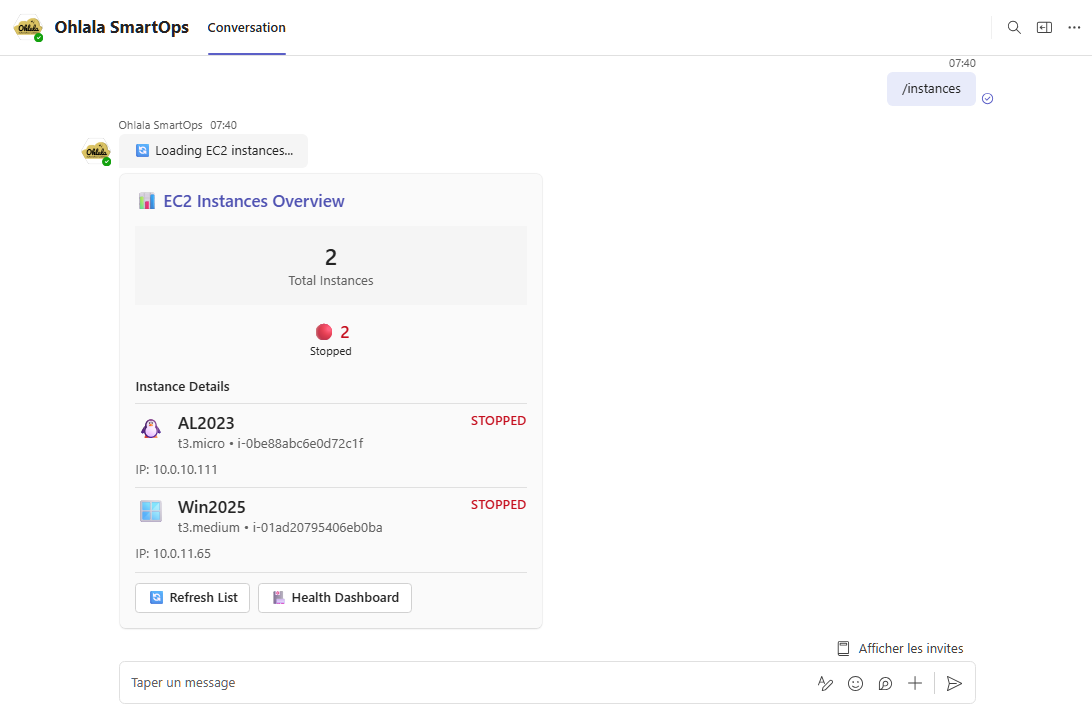
/health
Purpose: Comprehensive health dashboard for instances
Usage:
/health - Show health dashboard for all instances
/health [instance-id] - Show health for specific instance
Response: Rich dashboard featuring:
- CPU, memory, and disk usage metrics
- SSM agent connectivity status
- Visual health indicators and charts
- System performance trends
- CloudWatch metrics integration
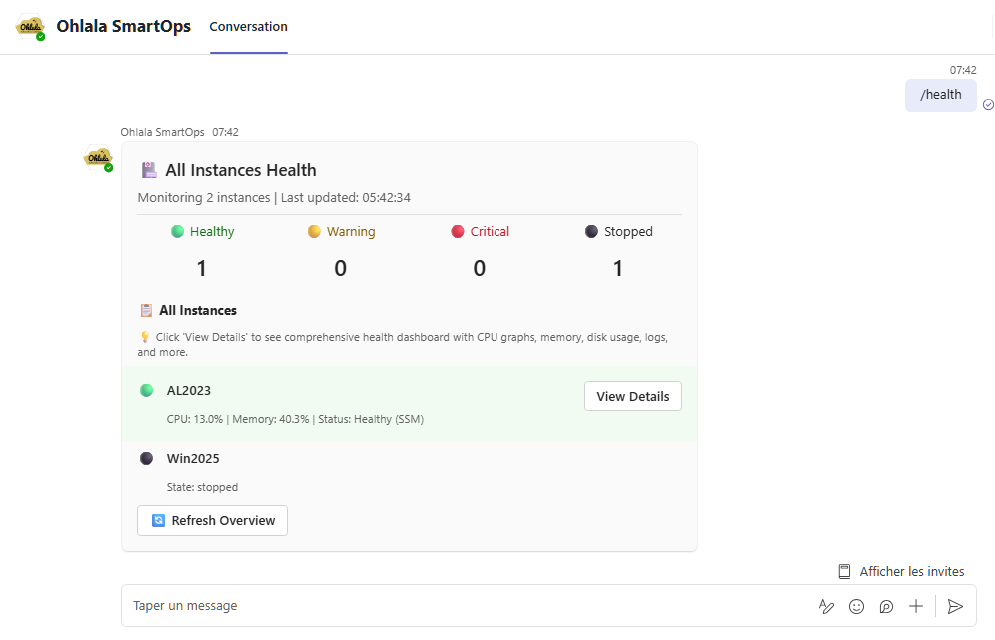
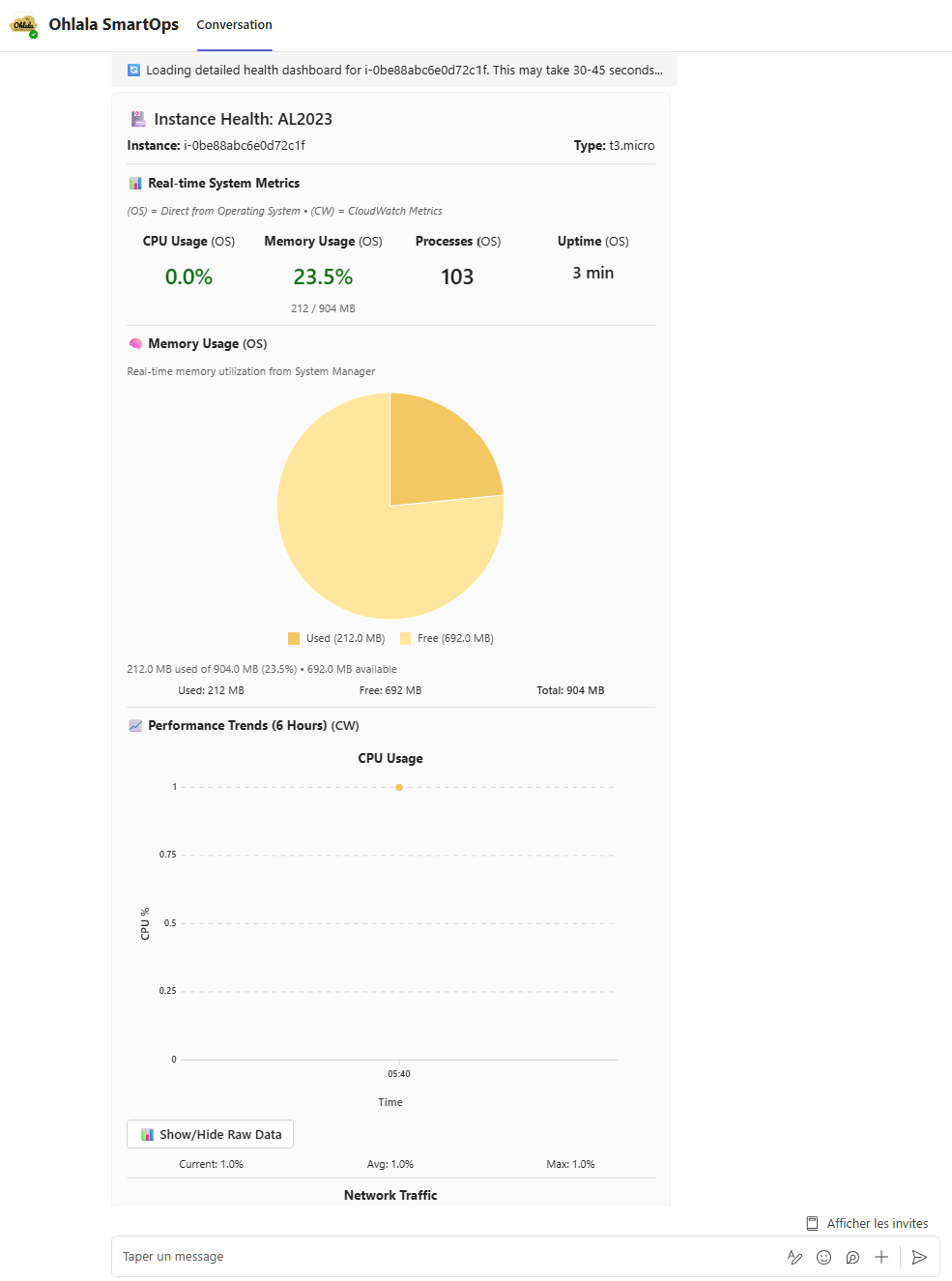
/rightsizing
Purpose: Cost optimization and rightsizing recommendations
Usage:
/rightsizing
Response: Cost optimization dashboard with:
- Current instance utilization analysis
- Rightsizing recommendations
- Potential cost savings calculations
- Instance type upgrade/downgrade suggestions
- CloudWatch metrics-based insights
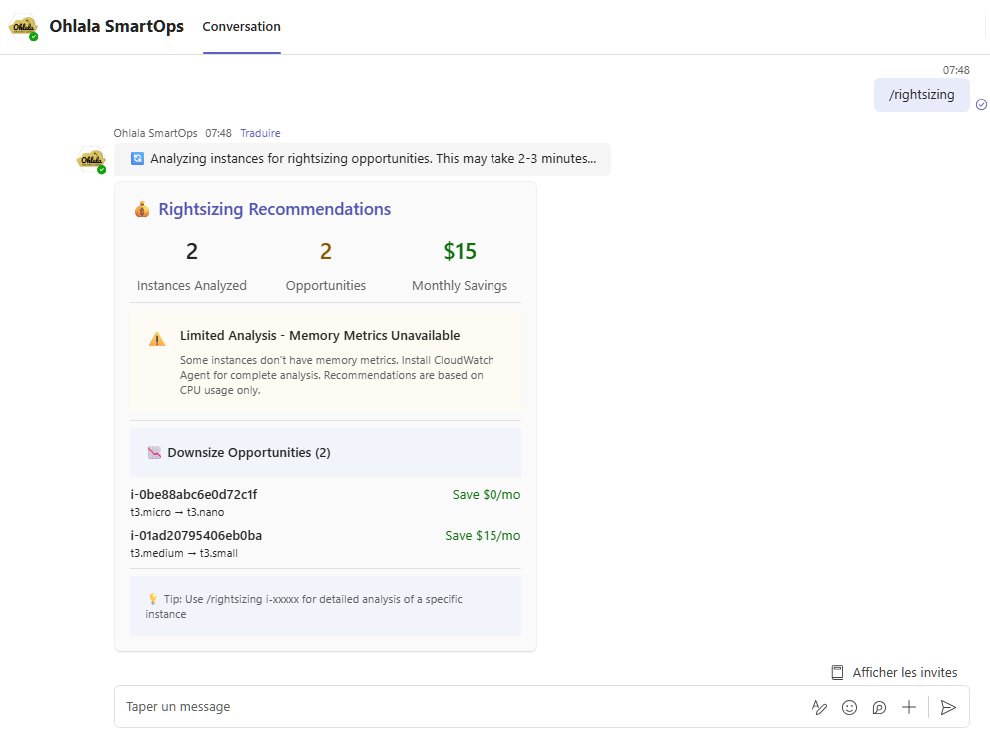
📊 Monitoring & Management Commands
/status
Purpose: Show pending commands and recent activity
Usage:
/status
Response: Command status dashboard showing:
- Currently pending SSM commands
- Recent command execution history
- Command success/failure rates
- AWS Console links for detailed monitoring
- Elapsed time for running operations
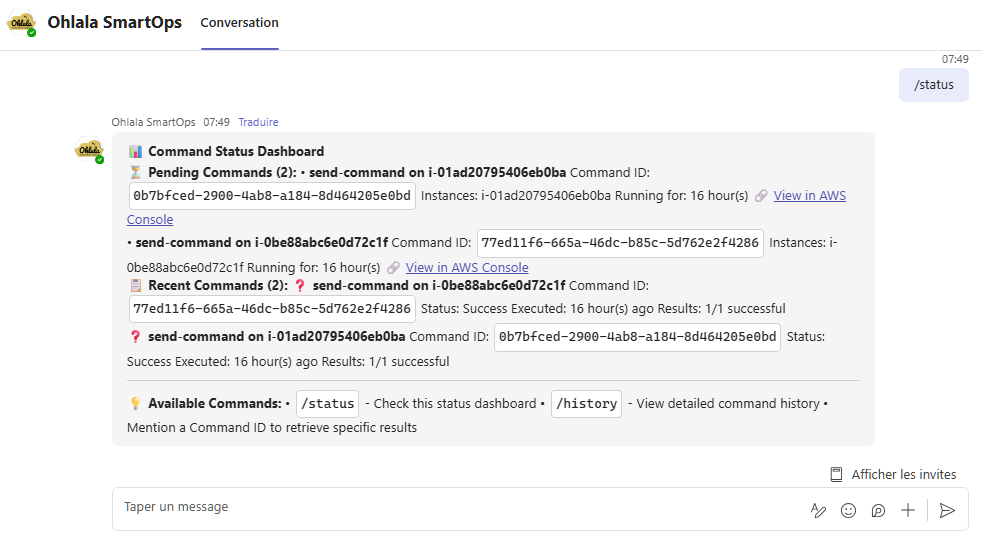
/history
Purpose: View detailed command execution history
Usage:
/history
Response: Comprehensive command history with:
- Past command executions
- Success/failure status
- Detailed results and outputs
- Timestamp and user information
- Filtering and search capabilities
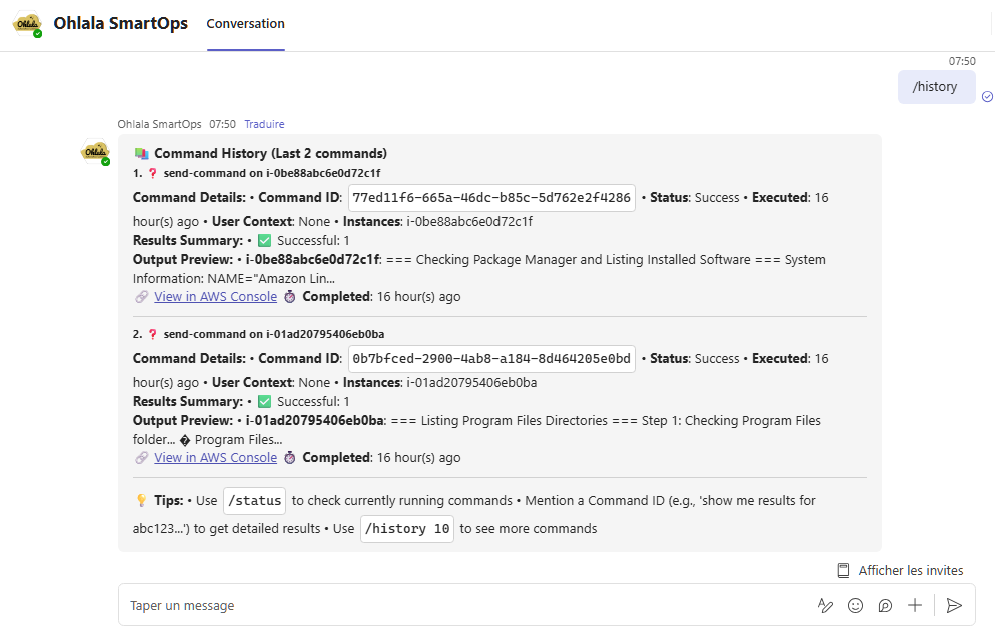
/token-usage
Purpose: Monitor Bedrock AI token usage and costs
Usage:
/token-usage
Response: Token usage analytics including:
- Current billing period usage
- Token consumption trends
- Cost breakdown by operation type
- Usage limits and quotas
- Optimization recommendations
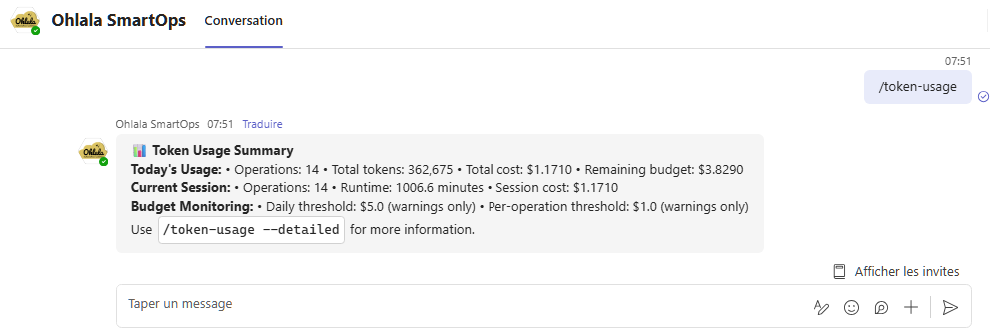
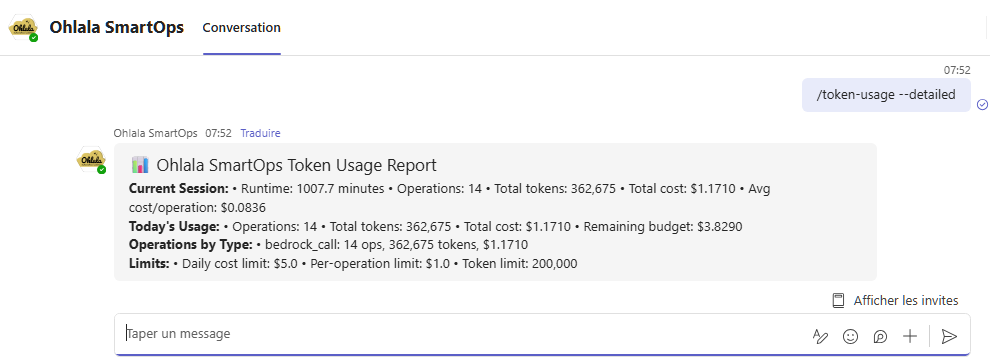
📝 Command Tips
Quick Access
- Type
/ in Teams to see all available slash commands - Commands are case-insensitive:
/help = /HELP = /Help - Use Tab completion in Teams for faster command entry
Combining with Natural Language
You can follow slash commands with natural language for more specific requests:
/health show me only instances with high CPU usage
/instances filter by production environment
/help with cost optimization
Command Parameters
- Most commands work without parameters for overview information
- Add instance IDs for specific instance details:
/health i-1234567890abcdef0 - Use
/help [command] for detailed usage instructions
Command History
- Use ↑ (up arrow) in Teams to repeat recent commands
- All commands are logged for audit purposes
- Interactive cards maintain state for better user experience
🔍 Command Comparison
| Command | Speed | Detail Level | Best For |
|---|
/instances | ⚡ Fast | 📊 Interactive | Instance management |
"show me my instances" | 🐌 Slower | 📖 Conversational | Analysis & insights |
/health | ⚡ Fast | 📈 Dashboard | Health monitoring |
"which instances need attention?" | 🐌 Slower | 🔍 AI Analysis | Troubleshooting |
/status | ⚡ Fast | 📋 Current | Operation tracking |
🚨 Error Handling
Common Issues
Command not recognized:
Unknown command: /instaces
Did you mean: /instances?
Missing permissions:
❌ Insufficient AWS permissions for this operation
Contact your administrator to review IAM policies
Service unavailable:
⚠️ AWS services temporarily unavailable
Try again in a few moments or use /status for details
Recovery Steps
- Check spelling - Commands must be exact
- Verify AWS permissions - Commands require proper IAM roles
- Try
/status - Check if services are operational - Use
/help - See all available commands
📖 Next Steps
Learn More
Quick Start
Try these commands right now in Teams:
/help - See what’s available/instances - View your EC2 instances with interactive controls/health - Check instance health dashboard/rightsizing - Discover cost optimization opportunities"show me instances that need attention" - Try natural language
🔄 Advanced Usage
Command Workflows
Combine slash commands for powerful workflows:
1. /instances → Click instance → View health details
2. /health → Identify issues → Use natural language for troubleshooting
3. /rightsizing → Review recommendations → Ask for implementation help
4. /status → Monitor ongoing operations → /history for detailed results
Interactive Features
- Action Buttons: Most commands include interactive buttons for common actions
- Context Preservation: Commands remember your selections for follow-up questions
- Real-time Updates: Health and status information refreshes automatically
- Multi-language Support: Commands adapt to your Teams language preference
Need Help?
2 - Command Examples & Usage
Detailed examples of all SmartOps commands with natural language variations and expected responses for EC2 management in Teams.
Command Examples & Usage
Comprehensive examples of all SmartOps commands with natural language variations and detailed response formats.
📝 Command Categories
Instance Management
List Instances
Shows all EC2 instances with current status and basic metrics.
Natural Language Examples:
- “What instances do I have?”
- “Show me all EC2 instances”
- “List my servers”
Direct Command:
@Ohlala SmartOps list instances
Response Format:
📊 EC2 Instance Summary
Found 5 instances in us-east-1
✅ web-server-01 (i-0abc123def)
Type: t3.medium | State: running
CPU: 45% | Memory: 62% | Disk: 38%
⚠️ database-01 (i-0def456ghi)
Type: m5.large | State: running
CPU: 78% | Memory: 85% | Disk: 72%
[... more instances ...]
Get Instance Details
Detailed information about a specific instance.
Natural Language Examples:
- “Tell me about instance i-0abc123def”
- “Show details for web-server-01”
- “What’s the configuration of my database server?”
Direct Command:
@Ohlala SmartOps describe instance <instance-id>
Response Format:
📋 Instance Details: web-server-01
Instance ID: i-0abc123def
Type: t3.medium (2 vCPU, 4 GB RAM)
State: running (since 2024-03-15 10:30 UTC)
Platform: Amazon Linux+
AZ: us-east-1a
Private IP: 10.0.1.45
Public IP: 54.123.45.67
Tags:
- Name: web-server-01
- Environment: production
- Team: platform
Monitoring:
- CPU: 45% (avg last hour)
- Memory: 62% (current)
- Network In: 125 MB/hour
- Network Out: 450 MB/hour
Health Monitoring
Health Report
Comprehensive health status of all instances.
Natural Language Examples:
- “Show me the health report”
- “How healthy are my instances?”
- “Give me a status update”
Direct Command:
@Ohlala SmartOps health report
Response Format:
🏥 Infrastructure Health Report
Generated: 2024-03-20 14:30 UTC
Overall Health: ⚠️ ATTENTION NEEDED
Summary:
✅ Healthy: 12 instances
⚠️ Warning: 3 instances
❌ Critical: 1 instance
Issues Requiring Attention:
❌ CRITICAL: app-server-03
- CPU: 95% (sustained for 30 min)
- Action: Consider scaling or investigating process
⚠️ WARNING: database-01
- Disk: 85% full
- Action: Clean up logs or expand storage
⚠️ WARNING: web-cache-02
- Memory: 88% utilized
- Action: Monitor for OOM issues
📈 Trends:
- CPU usage up 15% from yesterday
- 2 new instances added this week
- Cost trending 8% over budget
Instance Health Check
Check health of specific instance.
Natural Language Examples:
- “Is web-server-01 healthy?”
- “Check the health of i-0abc123def”
- “How is my database server doing?”
Direct Command:
@Ohlala SmartOps check health <instance-id>
Cost Optimization
Cost Analysis
Analyze EC2 costs and identify savings opportunities.
Natural Language Examples:
- “Analyze my EC2 costs”
- “Where can I save money?”
- “Show me cost optimization opportunities”
Direct Command:
@Ohlala SmartOps cost analysis
Response Format:
💰 EC2 Cost Analysis Report
Period: Last 30 days
Current Spending:
- Total: $3,456.78
- On-Demand: $2,890.45 (84%)
- Reserved: $566.33 (16%)
- Spot: $0.00 (0%)
Top Recommendations:
1. 🎯 Right-size Overprovisioned Instances
Potential Savings: $456/month (13%)
- web-server-01: t3.medium → t3.small
Current: 15% CPU avg → Save $28/month
- test-server-02: m5.xlarge → m5.large
Current: 8% CPU avg → Save $95/month
2. 💼 Purchase Reserved Instances
Potential Savings: $890/month (26%)
- 5 instances running 24/7
- Recommend 1-year no upfront RIs
3. 🌙 Implement Schedule-Based Scaling
Potential Savings: $234/month (7%)
- Dev/test instances can be stopped nights/weekends
- 10 instances identified
Total Potential Savings: $1,580/month (46%)
Rightsizing Recommendations
Get specific rightsizing suggestions.
Natural Language Examples:
- “Which instances should I rightsize?”
- “Show me oversized instances”
- “Find underutilized servers”
Direct Command:
@Ohlala SmartOps rightsizing recommendations
Troubleshooting
Troubleshoot Instance
AI-guided troubleshooting for instance issues.
Natural Language Examples:
- “My web server is slow”
- “Help me troubleshoot i-0abc123def”
- “Database connections are timing out”
Direct Command:
@Ohlala SmartOps troubleshoot <instance-id>
Interactive Response:
🔧 Troubleshooting Assistant
I'll help you troubleshoot web-server-01. Let me gather some information...
Current Status:
- Instance is running
- CPU: 45% (normal)
- Memory: 92% (HIGH)
- Disk I/O: Normal
- Network: Normal
⚠️ High memory usage detected!
Let me check what's consuming memory...
[Running diagnostic commands via SSM]
Top Memory Consumers:
1. java process: 2.8 GB (70%)
2. mysql: 650 MB (16%)
3. nginx: 120 MB (3%)
Recommendations:
1. Immediate: Restart the Java application
2. Short-term: Increase instance type to t3.large
3. Long-term: Investigate memory leak in application
Would you like me to:
A) Restart the Java application now
B) Show application logs
C) Create a snapshot before changes
Find Issues
Identify instances with problems.
Natural Language Examples:
- “Which instances need attention?”
- “Show me problematic servers”
- “Find unhealthy instances”
Direct Command:
@Ohlala SmartOps find issues
Remote Execution
Execute Command
Run commands on instances via SSM.
Natural Language Examples:
- “Run ‘df -h’ on web-server-01”
- “Check disk space on all instances”
- “Restart nginx on the web servers”
Direct Command:
@Ohlala SmartOps execute "<command>" on <instance-id>
Safety Features:
- Confirmation required for all SSM commands
- Commands run with limited privileges
- Audit trail maintained
- Output limited to 24,000 characters
Response Format:
🔨 Command Execution Request
Target: web-server-01 (i-0abc123def)
Command: systemctl restart nginx
⚠️ This command will restart the nginx service.
This may cause brief downtime.
Type 'yes' to confirm execution
[After confirmation]
✅ Command Executed Successfully
Output:
nginx.service - The nginx HTTP Server
Loaded: loaded (/usr/lib/systemd/system/nginx.service; enabled)
Active: active (running) since Thu 2024-03-20 15:45:32 UTC
Execution Time: 1.2 seconds
Command ID: abc-def-ghi-123
Instance Control
Start Instance
Start stopped instances.
Natural Language Examples:
- “Start web-server-01”
- “Boot up the test environment”
- “Turn on i-0abc123def”
Direct Command:
@Ohlala SmartOps start instance <instance-id>
Stop Instance
Stop running instances.
Natural Language Examples:
- “Stop the dev server”
- “Shut down test-instance-02”
- “Turn off i-0abc123def”
Direct Command:
@Ohlala SmartOps stop instance <instance-id>
Safety Confirmation:
⚠️ Stop Instance Confirmation
You're about to stop: prod-database-01
Environment: production
Current connections: 45
This action will:
- Terminate all active connections
- Stop the instance (data on instance store volumes will be lost)
- Incur no further hourly charges
Type 'yes' to confirm stopping this instance
Reboot Instance
Restart instances gracefully.
Natural Language Examples:
- “Reboot web-server-01”
- “Restart my application server”
- “Perform a soft reset on i-0abc123def”
Direct Command:
@Ohlala SmartOps reboot instance <instance-id>
Scheduling
Schedule Report
Set up automated daily reports.
Natural Language Examples:
- “Send me a daily health report at 9 AM”
- “Schedule cost reports every Monday”
- “Set up morning status updates”
Direct Command:
@Ohlala SmartOps schedule daily report at <time>
Get Help
Show available commands and usage.
Natural Language Examples:
- “Help”
- “What can you do?”
- “Show me available commands”
Direct Command:
@Ohlala SmartOps help
Response Format:
🤖 Ohlala SmartOps - Command Reference
I understand natural language! Just describe what you need.
You can also use these commands:
📊 Monitoring
• list instances - Show all EC2 instances
• health report - Comprehensive health status
• check health <id> - Check specific instance
💰 Cost Optimization
• cost analysis - Analyze spending
• rightsizing recommendations - Find savings
🔧 Troubleshooting
• troubleshoot <id> - AI-guided diagnostics
• find issues - Identify problems
🔨 Remote Execution
• execute "<command>" on <id> - Run via SSM
⚙️ Instance Control
• start/stop/reboot instance <id>
📅 Scheduling
• schedule daily report at <time>
💡 Tips:
- Use instance names or IDs
- Ask follow-up questions
- Natural language works best!
Need more help? Visit docs.ohlala.cloud
🔄 Advanced Features
Bulk Operations
Execute commands across multiple instances:
@Ohlala SmartOps execute "sudo yum update -y" on tag:Environment=dev
Filtering
Filter instances by various criteria:
@Ohlala SmartOps list instances where cpu > 80%
@Ohlala SmartOps find instances tagged Environment=production
Chaining Commands
Combine multiple operations:
@Ohlala SmartOps stop all dev instances then create ami backups
📖 Next Steps
Need Help?
3 - Natural Language Processing
Learn how SmartOps understands context and intent through natural language processing, fuzzy matching, and conversational AI.
Natural Language Processing
SmartOps uses Claude AI to understand context and intent, making infrastructure management feel like a natural conversation.
💡 AI Response Variability
SmartOps uses AI to understand your requests, which means responses may vary slightly between similar questions. This natural variation makes conversations more intuitive, but our approval system ensures safety - any potentially dangerous operations require explicit confirmation before execution.🎯 Natural Language Processing Features
SmartOps uses Amazon Bedrock’s Claude AI to understand context and intent. Examples:
Context Awareness
User: "Show me expensive instances"
Bot: [Lists instances sorted by cost]
User: "Which of those can be rightsized?"
Bot: [Understands "those" refers to expensive instances]
Intent Recognition
User: "My website is down"
Bot: "I'll help troubleshoot. Let me check your web servers..."
[Automatically identifies web-tagged instances and checks health]
Fuzzy Matching
User: "Check the databse server"
Bot: "Checking database-server-01..."
[Handles typos and variations]
🤖 How SmartOps Understands You
1. Intent Classification
SmartOps recognizes different types of requests:
Information Requests:
- “What instances do I have?”
- “Show me the current status”
- “How much am I spending?”
Action Requests:
- “Restart the web server”
- “Stop the test instances”
- “Update all development servers”
Troubleshooting Requests:
- “My application is slow”
- “Why is the database not responding?”
- “Help me fix this error”
2. Context Tracking
SmartOps remembers conversation context:
Example Conversation:
User: "List my production instances"
Bot: [Shows 5 production instances]
User: "Which one has the highest CPU?"
Bot: "Among your production instances, web-prod-02 has the highest CPU at 78%"
User: "Show me more details about that one"
Bot: [Shows detailed info for web-prod-02]
User: "Can you help me optimize it?"
Bot: "I can help optimize web-prod-02. Let me analyze its usage patterns..."
3. Entity Recognition
SmartOps identifies specific entities in your requests:
Instance References:
- Instance IDs: “i-0abc123def”
- Instance names: “web-server-01”
- Tags: “all production instances”
- Roles: “database servers”, “web servers”
Time References:
- “last week”, “yesterday”, “this month”
- “since 9 AM”, “in the past hour”
Metric References:
- “high CPU”, “low memory”, “disk space”
- “expensive instances”, “underutilized servers”
💬 Conversation Patterns
Follow-up Questions
After any response, you can ask natural follow-ups:
After Health Report:
- “What’s causing the high CPU on server-01?”
- “How can I fix the memory issue?”
- “Should I be worried about that warning?”
After Cost Analysis:
- “How much would rightsizing save me?”
- “Which instances should I prioritize?”
- “Can you help me implement those recommendations?”
After Instance List:
- “Which ones need updates?”
- “Show me only the problematic ones”
- “What would you recommend for optimization?”
Conversational Shortcuts
SmartOps understands casual language:
Informal Requests:
- “What’s up with my servers?” → Health status check
- “How are things looking?” → Overall status report
- “Any issues I should know about?” → Problem identification
- “Can you help me save money?” → Cost optimization analysis
Implicit Context:
- “Restart it” (after discussing a specific instance)
- “Show me more” (after any report or list)
- “What do you think?” (asking for AI recommendations)
🔍 Advanced Language Features
Comparative Queries
User: "Which instances use more CPU than database-01?"
User: "Show me servers that cost more than $100/month"
User: "Find instances smaller than t3.medium"
Temporal Queries
User: "What happened to web-server-01 yesterday?"
User: "Show me cost trends over the last 3 months"
User: "Which instances were restarted this week?"
Conditional Logic
User: "If the CPU is over 80%, show me the top processes"
User: "When database connections exceed 50, check memory usage"
User: "Alert me if any production instance goes down"
Aggregation Requests
User: "Total cost of all development instances"
User: "Average CPU across web servers"
User: "Count of instances by environment"
🎭 Handling Ambiguity
When your request is unclear, SmartOps will ask for clarification:
Example Ambiguous Requests:
User: "Restart the server"
Bot: "I found 5 servers. Which one would you like me to restart?
- web-server-01 (production)
- web-server-02 (production)
- app-server-01 (staging)
- db-server-01 (production)
- test-server-01 (development)"
User: "Stop the expensive instances"
Bot: "I found 3 instances with costs over $200/month. Would you like to:
A) See details about these instances first
B) Stop all 3 instances
C) Stop only non-production instances"
🔧 Error Recovery
SmartOps handles common communication issues:
Typos and Misspellings
User: "chck the helth of web-srvr-01"
Bot: "Checking the health of web-server-01..."
[Automatically corrects and understands intent]
Incomplete Requests
User: "show instances"
Bot: "Here are your EC2 instances. Would you like me to:
- Show more details about any specific instance
- Filter by environment or status
- Include cost or performance information"
Mixed Languages (Limited)
User: "montrer les instances"
Bot: "I understand you want to see instances. Here are your EC2 instances..."
[Basic French recognition, responds in English]
📚 Learning from Context
SmartOps learns patterns within a conversation:
Preference Learning
User: "Show instances without IDs"
Bot: [Remembers preference for this conversation]
User: "Now show the database servers"
Bot: [Lists database servers without IDs, as previously requested]
Domain Knowledge
SmartOps understands infrastructure terminology:
Technical Terms:
- “Load balancer”, “auto-scaling group”, “availability zone”
- “RDS”, “EBS”, “VPC”, “security group”
- “Production”, “staging”, “development” environments
Common Patterns:
- “Scale up/down”, “failover”, “backup”
- “Peak hours”, “maintenance window”, “scheduled downtime”
- “Performance bottleneck”, “capacity planning”
🎯 Best Practices for Natural Communication
1. Be Conversational
- Use natural language like you’re talking to a colleague
- Don’t worry about exact command syntax
- Feel free to ask follow-up questions
2. Provide Context
- Mention environment: “production servers”, “dev instances”
- Include timeframes: “since yesterday”, “this week”
- Specify scope: “all web servers”, “just the database”
3. Ask for Clarification
- If responses aren’t what you expected, ask for clarification
- Request more details: “Can you explain that further?”
- Ask for alternatives: “What other options do I have?”
4. Build on Previous Responses
- Use “that instance”, “those servers”, “the expensive ones”
- Ask follow-ups: “What would you recommend?”, “Should I be concerned?”
🔗 Integration with Commands
Natural language seamlessly integrates with command execution:
User: "The production web servers seem slow, can you help?"
Bot: "I'll investigate your production web servers. Let me check their current status...
Found 3 production web servers:
- web-prod-01: CPU 45%, Memory 78%
- web-prod-02: CPU 89%, Memory 92% ⚠️
- web-prod-03: CPU 52%, Memory 65%
web-prod-02 appears to have high resource usage. Would you like me to:
A) Show detailed process information
B) Restart the web services
C) Investigate recent logs
D) Recommend instance scaling"
📖 Next Steps
Need Help?








